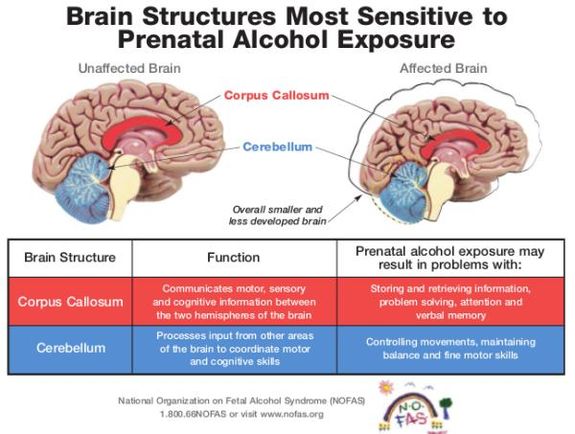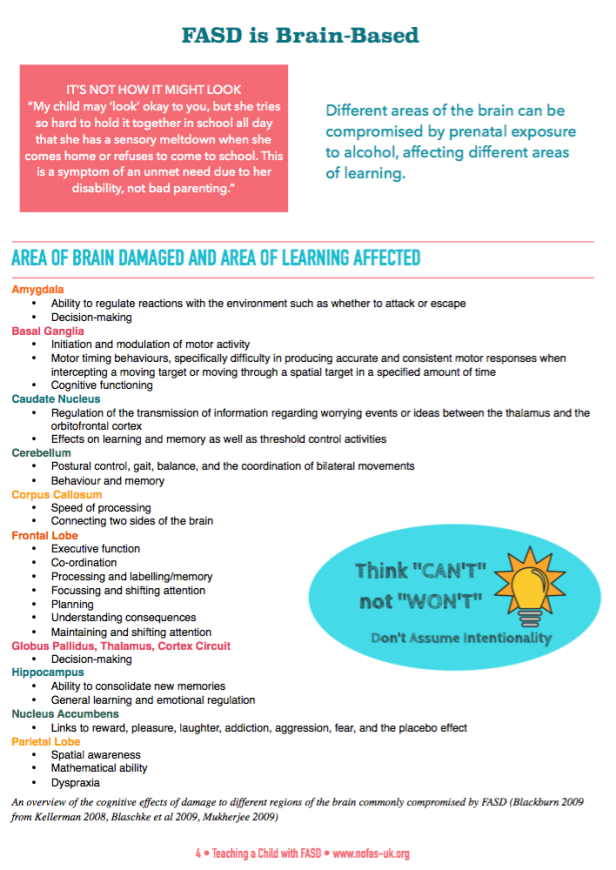It wasn’t until our son received his FASD diagnosis that we began to understand that he has an invisible physical disability that impacts every moment of his life. We felt bad that we didn’t understand him properly up to that point. Had he been missing a limb or if he were deaf, we would have taken immediate steps to address the physical need. But because we could not see that damage was done to his brain when he was in utero, we took too many long years to begin to understand that like a blind person, he too needs accommodation and support. There is much we still don’t know and every child is different. But we walk forward in faith that the brain and its complicated neural networks are miraculous. If our son’s brain is not able to send signals the usual way, we hope to feed the other pathways, through other senses and through other triggers. We seek to create a positive learning experience for him. We hope he will continue to grow in the knowledge that we do not blame him for whatever damage was done inside his head before he took his first breath. We hope he knows we will always try to help him better understand what works for hm and what support he needs to get through his day. We believe this knowledge one day may save his life.
This is an introduction for young people. A PDF is available from NOFAS-UK.


Source: Teaching a Student With FASD, NOFAS-UK
FASD is a Disability Not a Behavior Issue
Resources:
- My Brain, Me and FASD, video and PDF of a booklet by NOFAS-UK.
- Prenatal Alcohol Exposure and the Developing Brain, video one of this excellent resource, Supporting Students with Fetal Alcohol Spectrum Disorders, developed by Dr. Jacqueline Pei and her colleagues, Stephanie Hayes and Alethea Heudes as a component of Professionals without Parachutes.
- Developmental Timeline of Alcohol-Induced Birth Defects, The Embryo Project Encyclopedia, by Erica O’Neil
- Minnesota scientists deploy high-tech tools to map damage from fetal alcohol, 18 November 2017.
- Neuroimaging and Fetal Alcohol Spectrum Disorders, by Andria L. Norman, Nicole Crocker, Sarah N. Mattson, and Edward P. Riley, 2009.
- At a Glance: 8 Key Executive Functions, by Amanda Morin
- Executive Function 101, by National Center for Learning Disabilities
- FASD: Trying Differently, Not Harder, by Diane Malbin – this book explains the link between the brain and the behavior (this book is also available online via Amazon)
- A Day in the Life of a Child With Executive Functioning Issues
- Teens With FASD: What Makes Them Tick? by Teresa Kellerman
- Cognitive Support™ Series, videos by the Oregon Behavior Consultation, which offer concrete steps on how to address cognitive skills challenges
- Triggers for Kids with Autism and Sensory Processing Disorders (infographic)
- The Brain Science that Changes Parenting, Rebecca Evans
- Brain Neuroplasticity: Our Body’s Backup System (infographic)
- How Brain Imaging Changes Everything (article about ADHD)
- Fetal alcohol spectrum disorder impacts brain development throughout childhood and adolescence not just at birth, Science Daily, 2013
- Like Sitting in a Room With Thousands of TVs: Inside the ADHD Brain, by Lisa Aro, 2 May 2014 (many kids with FASD also are diagnosed with ADHD, this post has ‘tips and tricks’ for dealing with some key issues related to ADHD)
- Perseveration, by FASD Network of Southern California
- FASD is brain injury – with video of 3 tips for talking to kids with acquired brain injury, Adoption Council of Ontario
- Getting Burned by FASD, a reflection on miscommunication and language, by R.J. Formanek, an adult with FASD
- Perry: Rhythm Regulates the Brain, AttachmentDisorderHealing.com, April 11, 2014
- Over 400 conditions co-occur with Fetal Alcohol Spectrum Disorders (FASD), study finds, Medical Express, January 5, 2016
- FASD: A guide for mental health professionals, by Jerrod Brown, Counselling Today, 10 July 2017
-
The Relation Between Theory of Mind and Executive Functions in Children with FASD, by Carmen Rasmussen, Katy Wyper, Victoria Talwar, Can J Clin Pharmacol Vol 16 (2) Summer 2009:e370-e380; July 26, 2009
-
Prenatal exposure to alcohol causes enduring brain damage, by WA Phillips, Adoption & Fostering, 2015, Vol. 39(3) 201–211
-
How Prenatal Alcohol Exposure Affects Development of the Brain, by Teresa Kellerman
Medication
- Attention-Deficit Hyperactivity Disorder: Clinical Implications of a Link Between Fetal Alcohol Spectrum Disorder and Attention-Deficit Hyperactivity Disorder, The Canadian Journal of Psychiatry, May 2002, on the different ways ADHD medications work for a person with FASD.
- The relationship between ADHD and fetal alcohol spectrum disorders, Raja Mukherjee, ADHD IN PRACTICE 2016; Vol 8 No 1
- Barry Stanley, “Beyond Diagnosis: Interventions for Individuals Living with Fetal Alcohol Spectrum Disorder.”
St. Michael’s Hospital, Toronto, September, 2005. - Medication Management in FASD (video), Dr. Shih, 2013.
- Medications for Children and Adults with FASD, 2009

An example of a chaotic system is the brain [a complex system ] that was exposed to the ubiquitous effects of prenatal alcohol.
The human brain is the most complex system known [on earth]. The developing brain that is exposed to prenatal alcohol becomes a complex chaotic system. Because of the interactive complexity of the brain there is no part of the developing brain that is not affected by prenatal alcohol exposure, either directly or indirectly. It is recognized that the effect of prenatal alcohol on the developing brain varies according to the amount consumed, the fetal level of the alcohol, the length of time of the exposure, the speed with which the alcohol is consumed, the time and frequency that the alcohol is consumed in the pregnancy, the nature and health of the placenta, the state of nutrition of the mother, the age of the mother and the epigenetic affect of alcohol on the sperm and oocyte. These many factors, together with the complexity of the developing brain, ensure that no two affected individuals will be identical in their disabilities. Barry Stanley
LikeLiked by 1 person
Thank you so much for your informative comment and for the good work you do to help others better understand this disability. This complexity and the differences in each person who is affected adds to the challenges of finding the best way forward. The first step of viewing the behaviors as symptoms of the underlying brain injury can be transformative.
LikeLike